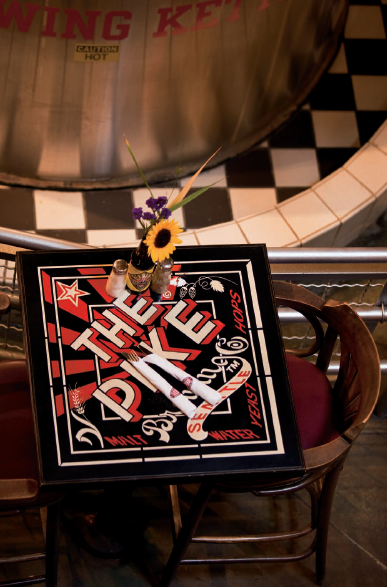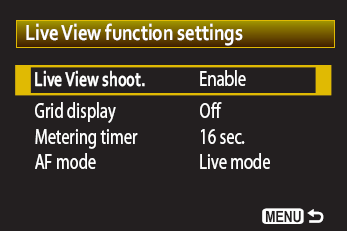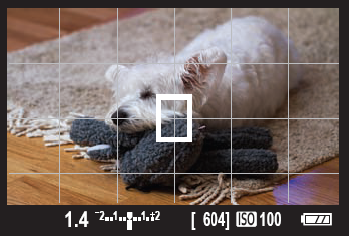Live View shooting enables you to view, compose, and focus using a real-time view of the scene on the camera's 3-inch LCD monitor. Alternately, you can shoot with the T2i/550D connected (tethered) to the computer, and then control image settings ranging from focus and exposure to white balance and Picture Style on the computer by using the EOS Utility program from Canon. Live View and tethered shooting give you added flexibility in shooting scenarios that normal shooting doesn't provide.

Live View shooting is an excellent choice for getting tack-sharp focus on a still subject such as these daisies. Exposure: ISO 100, f/2.2, 1/2500 second.
While Live View shooting is a staple feature on point-and-shoot digital cameras, it is a relatively new feature for digital SLR cameras such as the T2i/550D. In fact, the concept of a digital SLR being able to hold the shutter open to give you a real-time view of the scene and yet pause long enough to focus is impressive. Normally, the camera can't see the live scene because the shutter and reflex mirror block the view to the image sensor. The T2i/550D overcomes this blind spot with a mechanical shutter that stays completely open during Live View shooting.
Live View offers some advantages that you don't get with non-Live View shooting. For example, Live View offers Face Detection that automatically identifies faces in the scene and focuses on one of the faces. And you can use the supplied or an accessory cable to connect the T2i/550D to a TV and see Live View on the TV screen.
Although Live View shooting has a high coolness factor, it comes at a price with a few side effects:
Temperature affects the number of shots you can get using Live View. With a fully charged LP-E8 battery, you can expect 200 shots without flash use and approximately 170 shots with 50 percent flash use in 73-degree temperatures. In freezing temperatures, expect 170 shots without flash use and 150 shots with 50 percent flash use per charge. With a fully charged battery, you get approximately one-and-a-half hours of continuous Live View shooting before the battery is exhausted.
High ambient temperatures, high ISO speeds, and long exposures can cause digital noise or irregular color in images taken using Live View. Before you start a long exposure, stop shooting in Live View and wait several minutes before shooting. With continual use of Live View, the sensor heats up quickly. Both high internal and external temperatures can degrade image quality and cause Live View to automatically shut down until the internal temperature is reduced.
An icon that resembles a thermometer is displayed on the LCD when internal and/or external temperatures are high enough to degrade image quality. If the icon appears, it's best to stop shooting until the temperature cools down. Otherwise, the camera will automatically stop shooting if the internal temperature gets too high. Additionally, high ISO settings combined with high temperatures can result in digital noise and inaccurate image colors.
The Live View may not accurately reflect the captured image in several different conditions. Image brightness may not be accurately reflected in low and bright-light conditions. If you move from low to a bright light and if the LCD brightness level is high, the Live View may display chrominance (color) noise, but the noise will not appear in the captured image. Suddenly moving the camera in a different direction can also throw off accurate rendering of the image brightness. If you capture an image in magnified view, the exposure may not be correct. And if you focus and then magnify the view, the focus may not be sharp.
While some key aspects of Live View shooting differ significantly from standard shooting, other aspects carry over to Live View shooting. For example, you can use the Quick Control screen during Live View shooting to change settings including the white balance, Picture Style, Auto Lighting Optimizer, Image Quality, drive mode, and focusing option. Likewise, you can press the Display button one or more times to change the display to include more or less shooting information along with a Brightness histogram. The following sections give you a high-level view of setting up for and using Live View shooting.
With the T2i/550D's large and bright LCD monitor, you can use Live View shooting to get tack-sharp focus. Here is an overview of the Live View focusing options so that you can decide in advance which is best for the scene or subject that you are shooting:
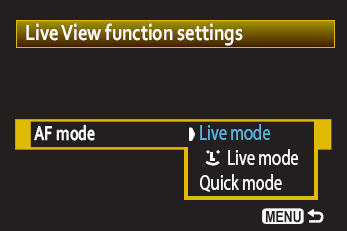
Figure 5.1. These are the focusing mode options that are available by selecting the Live View function settings/AF mode on the Setup 2 menu.
Live mode. With this focusing option, the camera's image sensor is used to establish focus. This focusing mode keeps the reflex mirror locked up so that the Live View on the LCD is not interrupted during focusing. However, focusing takes longer with Live mode. To focus in this mode, press a cross key to move the focusing rectangle over the subject, and then press the Shutter button halfway to focus. The AF point turns green when focus is achieved.
Face Detection Live mode. This is the same as Live mode except that the camera automatically looks for and focuses on a human face in the scene. If the camera does not choose the face of the subject you want, you can move the focusing frame to the correct face. If the camera cannot detect a face, then the AF point reverts to the center AF point, and you can manually move the AF point to a face.
If the person is a long way from the camera, you may need to manually focus to get the subject in reasonable focus range, and then focus by half-pressing the Shutter button. Face detection does not work with extreme close-ups of a face, if the subject is too far away, too bright or dark, partially obscured, or is tilted horizontally or diagonally. In Face Detection Live mode, you can't magnify the image on the LCD using the AF-point selection/Magnify button. In both Live and Face Detection Live modes, focus at the edges of the frame is not possible and the face focusing frame is grayed out. Instead, the Rebel switches to the center AF point for focusing.
Quick mode. This focusing mode uses the camera's autofocus sensor to focus. In this mode, when the camera focuses, it suspends the Live View on the LCD long enough for the reflex mirror to drop down so the camera can establish focus. With Quick mode focusing, you can select any of the nine AF points by pressing the Q button, and then pressing the left or right cross key to turn on AF point selection. Then turn the Main dial to select an AF point. Then half-press the Shutter button to focus and make the picture.
Manual Focus. This focusing option is the most accurate, and you get the best manual focusing results when you magnify the image to focus. Another advantage is that Live View is also not interrupted during focusing. To focus manually, you need to have a lens that offers a manual focus (MF) switch on the side of the lens. Then set the lens switch to MF (Manual Focus), and then move the focusing frame wherever you want. Turn the focusing ring on the lens to focus.
Note
If you use Live View with Continuous shooting, the exposure is set for the first shot and is used for all images in the burst. If the light changes during a burst of shots, the exposure may not be correct.
For Live View, the camera uses Evaluative metering. Unlike standard shooting, the most recent meter reading is maintained for a minimum of 4 seconds even if the lighting changes. You can set how long the camera maintains the current exposure by setting the Live View Metering timer from 4 seconds to 30 minutes. If the light or your shooting position changes frequently, set a shorter meter time. Longer meter times speed up Live View shooting operation, and longer times are effective in scenes where the lighting remains constant.
Note
Auto Lighting Optimizer automatically corrects underexposed and low-contrast images. If you want to see the effect of exposure modifications, then turn off Auto Lighting Optimizer on the Shooting 2 menu.
When shooting in Live View with the built-in flash, the shooting sequence (after fully pressing the Shutter button) is for the reflex mirror to drop to allow the camera to gather the preflash data. The mirror then moves up out of the optical path for the actual exposure. As a result, you hear a series of clicks, but only one image is taken. Here are some things you should know about using Live View shooting with a flash unit:
With an EX-series Speedlite, FE Lock, modeling flash, and test firing cannot be used except for wireless flash shooting.
Flash Exposure Lock cannot be used with the built-in or an accessory Speedlite.
The settings on the Setup 2 menu not only activate Live View shooting, but they also enable you to set your preferences for shooting in this mode, including enabling Live View shooting, displaying a grid in the LCD, and setting the Exposure metering timer.
To set up the T2i/550D for Live View shooting and to set your preferences, follow these steps:
With the Mode dial set to P, Tv, Av, M, or B, press the Menu button, and then turn the Main dial to select the Setup 2 tab.
Press the down or up cross key to highlight Live View function settings, and then press the Set button. The Live View function settings screen appears.
Press the up or down cross key to select Live View shoot., and then press the Set button. The Enable and Disable options appear.
Press the up or down cross key to select Enable, and then press the Set button.
On the Live View function settings screen menu, press the down cross key to highlight any of the following options, and then press the Set button to display the settings you can select.
Grid display. Select a 3 × 3 or 4 × 6 grid to help you align horizontal and vertical lines in the scene. Or select Off if you do not want to use a grid, and then press the Set button.
Metering timer. Choose 4, 16, or 30 seconds, or 1, 10, or 30 minutes to determine how long the camera retains the exposure, and then press the Set button. If the light changes often, choose a shorter time.
AF mode. Select Live mode, Face Detection Live mode, or Quick mode, and then press the Set button.
Now that you've chosen the focusing mode and selected the shooting options, you're ready to begin shooting. Here are a few tips to get you started:
For still life and macro shooting, manual focusing with the image enlarged to 5 or 10X helps ensure tack-sharp focus. To enlarge the view, press the AF-point selection/Magnify button on the top right back of the camera. Note that manual focusing is possible only with lenses that have a manual focusing switch on the side of the lens barrel.
For a really large view, tether the camera to your laptop using the supplied USB cable, or you can hook up the camera to the TV and use the TV screen as a monitor.
Note
See Chapter 2 for details on connecting the T2i/550D to a TV.
Just a few minutes of watching the real-time view will convince you that a tripod is necessary for Live View shooting. With any focal length approaching telephoto, Live View provides a real-time gauge of just how steady or unsteady your hands are.
The operation of the camera during Live View shooting differs from traditional still shooting, but the following steps guide you through the controls and operation of the camera.
To shoot in Live View using autofocus, follow these steps:
With the camera set to any shooting mode and with Live View enabled on the Setup 2 menu, press the Live View/Movie shooting button on the back of the camera. A current view of the scene appears on the LCD.
Press the Q button to display the Quick Control screen. From here you can press a cross key to change settings such as the white balance, Picture Style, and so on. You can press the Q button a second time to display the grid if you turned on the grid option.
Press the Display button one or more times to show more or less information, and to display the histogram.
Compose the image by moving the camera or the subject. As you move the camera, the exposure changes and is displayed in the bottom bar under the Live View display. If the histogram is displayed, it shows the changes as you move the camera as well.
If you are using Quick mode to focus, press the Q button to display the Quick Control screen, press the right cross key to activate AF-point selection, and then turn the Main dial to select the AF point that you want. In Live Focusing mode, press a cross key to move the focus point.
Press the AF-point Selection/Magnify button on the top far-right corner of the camera to magnify the view. The first press of the button enlarges the view to 5X, and a second press enlarges the view to 10X. The magnifications are shown on the LCD as X5 and X10. You cannot magnify the image if you're using Face Detection Live mode focusing.
Press the Shutter button completely to make the picture. The shutter fires to make the picture, the image preview is displayed, and then Live View resumes.
One of the most useful ways to use Live View shooting is for shooting in a studio, particularly when you shoot still-life subjects such as products, food, stock shots, and portraits. You can set up with the T2i/550D connected to a computer using the USB cable supplied with the camera. The extra-long cord allows a good range of movement, particularly if the computer is on a wheeled or swivel table.
Before you begin, install the EOS Digital Solution Disk on the computer to which you are connecting the camera. To shoot in Live View with the T2i/550D tethered to the computer, follow these steps:
Turn off the camera and attach the USB cord to the Digital terminal located under the terminal cover on the side of the camera. Be sure that the icon on the cable connector faces the front side of the camera.
Connect the other end of the USB cable to a USB terminal on the computer.
Turn on the power switch on the camera. If this is the first time you've connected the camera to the computer, then the computer installs the device driver software and identifies the camera.
Click Camera settings/Remote shooting in the EOS Utility window. The EOS T2i/550D control panel appears. You can use the panel to control exposure settings, set the white balance, set the Picture Style, and set White Balance Shift.
Click Preferences to set the options you want, such as choosing the destination folder in which to save captured images and whether to save the images both on the computer and on the media card.
Click Remote Live View Shoot... toward the bottom of the Remote Shooting control panel. The Remote Live View window appears and the camera reflex mirror flips up to preview the scene on the computer screen. In this window, you can set the white point by clicking a white area or neutral gray area in the scene, use the controls to set the focus, preview the depth of field by clicking the On button, and switch between the Brightness and RGB histograms as well as view the image magnified to tweak focus.
Press the Shutter button in the EOS Utility Control Panel to take the picture. The Digital Photo Professional main window opens with the image selected.
When you finish, turn off the camera and disconnect the USB cable from the camera.

Figure 5.6. I set the white balance by clicking the White Balance eyedropper and clicking on the white background.
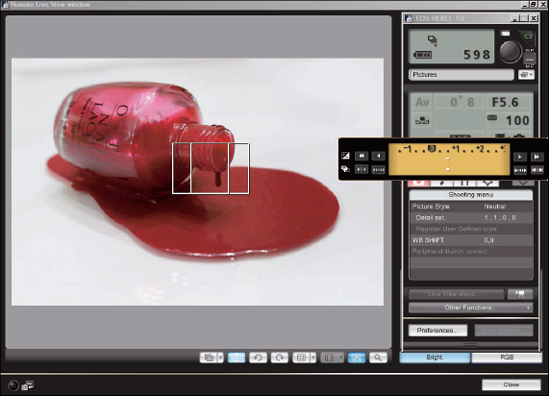
Figure 5.8. You can set Exposure Compensation during tethered shooting, and in this scene, it increased the brightness for a truer white rendering.

Figure 5.9. This is the final image taken in Live View shooting with Remote shooting using the EOS Utility with the camera tethered to a laptop. Exposure: ISO 100, f/5.6, 1/8 second with a +2/3-stop of Exposure Compensation.
